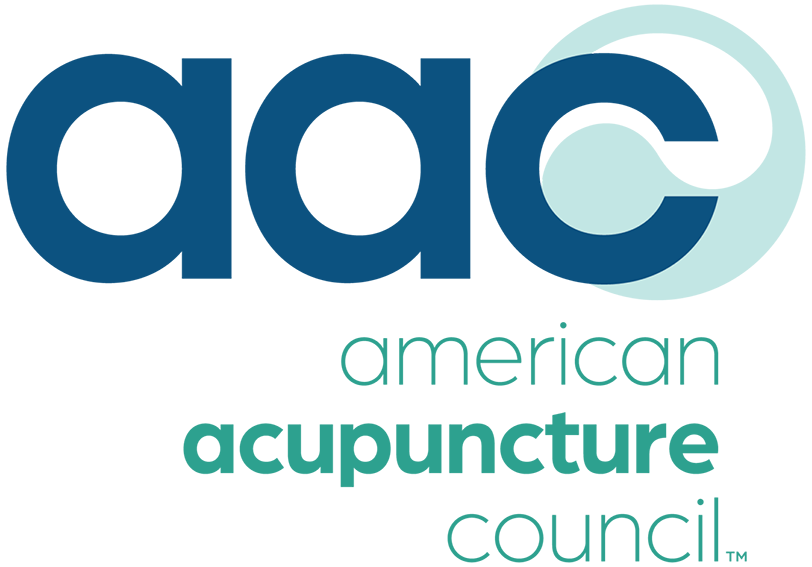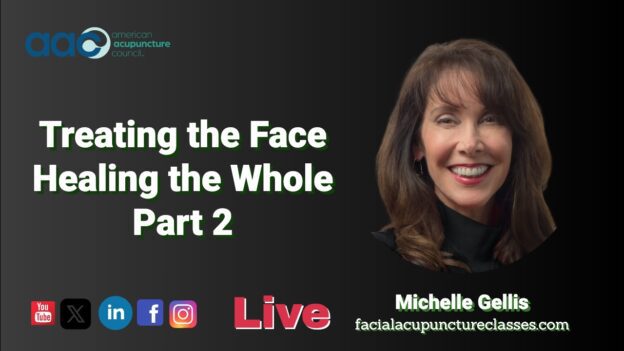So there are quite a few neuromuscular conditions that affect the face, such as Bell’s Palsy, Ramsey Hunt Syndrome, synchronic cys, stroke, TMJ, trigeminal Neuralgia,…
Click here to download the transcript.
Disclaimer: The following is an actual transcript. We do our best to make sure the transcript is as accurate as possible, however, it may contain spelling or grammatical errors. Due to the unique language of acupuncture, there will be errors, so we suggest you watch the video while reading the transcript.
Hi, my name’s Michelle Gellis. I am an acupuncture physician, and I would like to thank the American Acupuncture Council for this opportunity for me to present to you today on treating the face a multidimensional approach. So today we’re going to do part two. And you can go ahead and go.
So a little bit about me. I’m currently on the doctoral faculty at Jossane University. Before that, I was a faculty member and clinic supervisor at the Maryland University of Integrative Health from 2003 until 2021. I am a published author and contributor to the Journal of Chinese Medicine and I’m a regular columnist for acupuncture today.
Click here for the best Acupuncture Malpractice Insurance
And I’ve been treated teaching facial acupuncture classes internationally since 2005. My book Treating the Face was released in November of 2024. It is a 500 page 15 chapter, hard cover book, and it covers all aspects of treating the face. I’m going to talk mostly about the information that’s in chapter six, and that is neuromuscular facial conditions.
So when we think about facial acupuncture, we tend to think about cosmetic facial acupuncture. But facial acupuncture is really about a holistic approach to not just treating the face. Cosmetically, but also all different aspects of treating the face. So there are quite a few neuromuscular conditions that affect the face, such as Bell’s Palsy, Ramsey Hunt Syndrome, synchronic cys, stroke, TMJ, trigeminal Neuralgia, Ms.
Get a Quick Quote and See What You Can Save
Whoops. Ms. Ptosis, HEFA spasm, myasthenia gravis, shingles, and facial ticks, just to name a few. And many of these are very unique to the face itself. And. Since I specialize in treating the face, after a few years of doing cosmetic acupuncture, I started getting people calling me, asking me if I could help them with a lot of these neuro conditions.
And through studying and doing a lot of research. I and some trial and error. I learned that the best way to really manage these conditions is through a multifaceted approach using scalp, acupuncture, submuscular needling, facial motor points, facial cupping. And so I’m gonna touch on these, the.
And so Scalp acupuncture is based on neuroanatomy. It is not based on acupuncture points. And you have to measure the scalp appropriately. And there’s a motor area and there’s a sensory area, and the bottom two fifths of each one of these lines, the sensory area is not shown on this picture. The. The bottom two fifths corresponds to the face, and so you would needle this area and stimulate it either with electro acupuncture or with manual stimulation in order to help with either motor conditions such as Bell’s palsy or with sensory conditions such as trigeminal neuralgia.
Facial motor points. This is from an old medical textbook. These are the motor points that have been discovered on the face, head and neck. And in part one of this talk I talked about using motor points for cosmetic concerns, but facial motor points are wonderful for neuromuscular concerns because what a motor point is the most electrically acceptable part.
The muscle where the motor neuron goes into the muscle, and by stimulating it, you can cause the muscle to get back into normal functioning. And the reason why this is important for the face, besides the functioning of opening the lid or closing the lid, the. Skin on the face is directly attached to the muscle.
So if someone’s face is paralyzed and is drooping in one area by getting the muscle back into normal functioning, by stimulating the motor point, the skin itself will. Snap back and be working in a more normal fashion with the muscle. So I do have examples of a couple of motor points. This was a student of mine in class and she had.
Had Bell’s Palsy many years ago and was still having trouble cursing her lips, whistling spitting like when she’d brush her teeth. And so I did the Mentalis Motorpoint and as soon as I put the needle in. Her chin started to twitch and then when I stimulated the point, it really started to jump.
And then after the treatment, she reported that she was able to make a lot of facial expressions that she hadn’t been able to make in the past.
Next example I have is a student in a class I was teaching in London and he had been in a bike accident and he had some neuropathy and a little ptosis on his left eyebrows and. I put this needle and stimulated it. So this is the motor point for the frontals. It’s gallbladder 14.
Sorry, that was so loud. But you could see the needle moving back and forth when, once it was put in the muscle, which meant it was starting to wake up. Submuscular needling is another technique that I use, which involves needling underneath and in some instances through a muscle in order to.
Blood and cheese circulation into the muscle itself. And I have a little demo here, which I.
Facial cupping and GU can also be very beneficial. For neuromuscular facial conditions, as long as your patient can tolerate it. These techniques are very gentle if done properly, and can help with blood and cheese circulation into the face. It can help with any sort of fascial adhesions. That is because over time.
If a muscle in the face isn’t used, the fascia can become stiff, and by using the cups it can help with lymphatic, the lymphatic system of the face, and it’s also very relaxing and very enjoyable for your patients. I am gonna talk really quickly about Bell’s Palsy. Bell’s Palsy is the most common cause of facial paralysis, usually temporary, and it’s caused by a disruption of the facial nerve, which causes either weakened or paralyzed facial muscles.
So here’s one patient you can see. This entire when asked to smile, they can only, she can only smile on one side of her face and the other side is completely paralyzed. This was a patient of mine. I only focused on her eyes, but I asked her to close her eyes. You can see one eye closed and the other one.
She could not close it at all. And then I did some submuscular needling and some acupuncture points and used gallbladder 14 as a motor point, did some scalp acupuncture for the face, and, after one month,
you can see she can close her eyes. Still a little difficult, but she had complete recovery.
So I do offer many different classes on. Facial and cosmetic acupuncture, you might wanna check those out. You can scan the QR code or go to my website, facial acupuncture classes.com and you can find me on social under my name, Michelle Gellis, or I have a Facebook group called Facial Acupuncture.
Very active group. Thank you so much.






